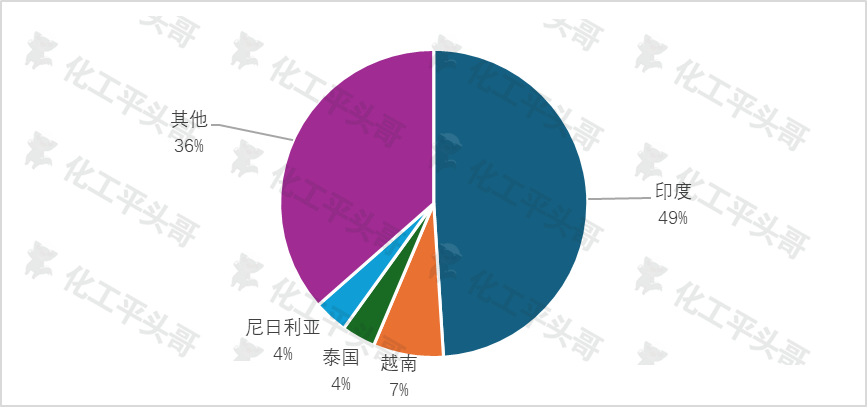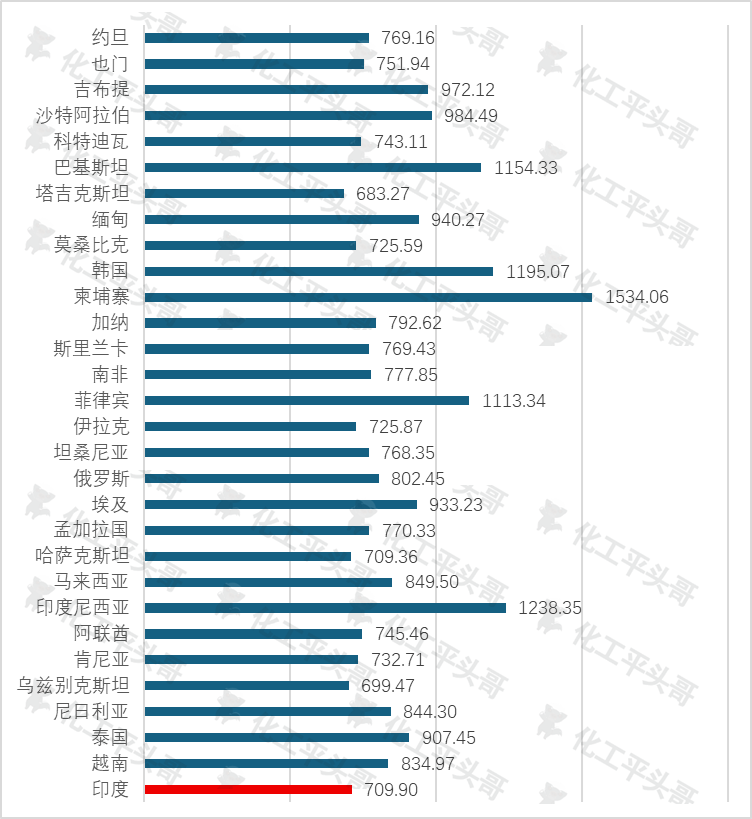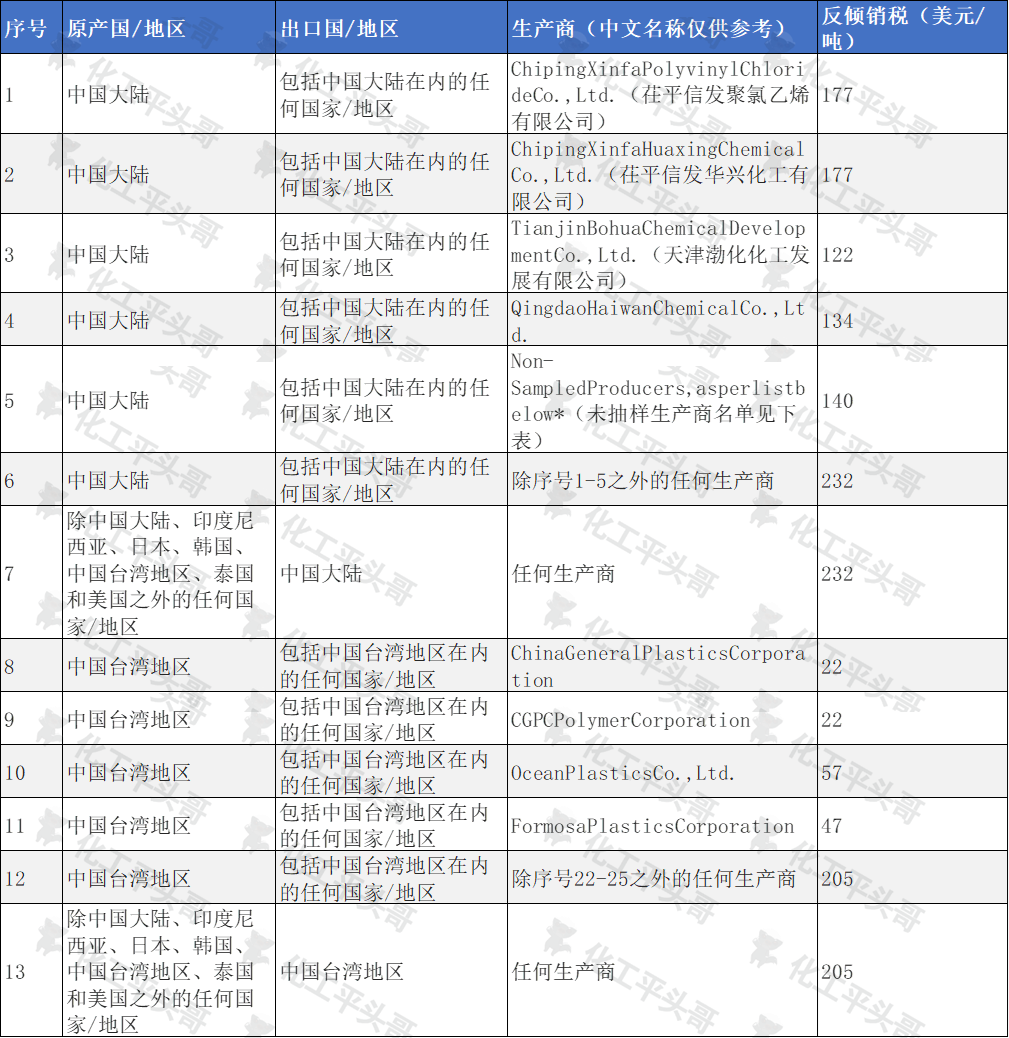1. 2025 India anti-dumping final ruling core content
1. Final tax rate and definition of the product in question
on August 14, 2025, India's Ministry of Commerce and Industry announced a five-year anti-dumping duty on PVC suspension resin (K value 55-77, under customs code 3904) in 7 countries/regions, of which China's tax rate is 122-232 USD/ton (major exporters correspond to 140-170 USD/ton), while other economies have the following tax rates respectively: indonesia 55-204 USD/ton, Japan 49-148 USD/ton, South Korea 0-169 USD/ton, Taiwan 22-205 USD/ton, Thailand 60-193 USD/ton, United States 72-284 USD/ton. China's tax rate is significantly higher than that of Japan and South Korea, directly related to the proportion of Chinese products in India.
Table 1 India's proposed final anti-dumping tax on China-related PVC suspension resins.
2. Direct impact on China's PVC exports
india is China's largest PVC exporter. In 2024, China's exports to India accounted for 49% of the total PVC exports, with an export volume of 1.33 million tons (accounting for more than 35% of India's total imports) and an average unit price of US $709/ton (medium and low level). According to the main tax rate of 140 US dollars/ton, the export unit price will rise to 849 US dollars/ton (high level); according to the highest tax rate of 232 US dollars/ton, the unit price will reach 941 US dollars/ton (China's export unit price is in the forefront), directly weakening the price competitiveness of Chinese products.
Figure 1 The proportion of countries in China's export scale.

Data source: General Administration of Customs of China
figure 2 China PVC export country unit price (USD/t)

Data source: General Administration of Customs of China
The Historical Evolution and Logic of India's PVC Anti-dumping Policy in 2.
1. Policy evolution: phased adjustment under long-term protection
india's anti-dumping policy against China's PVC began in 2006, and the first final tax of 61.25-147.96 USD/ton was levied in 2007. The first sunset review in 2014 maintained the original tax rate and abolished the tax on South Korea. The second sunset review in 2019 will uniformly reduce the tax rate of China's responding enterprises to the lawsuit to US $61.14/ton (the tax rate for non-responding enterprises is higher); After the anti-dumping duty expires in February 2022, India did not immediately postpone, forming a policy gap.
2. The causal link between the gap period and the final tax increase.
During the policy gap period from mid -2022 to March 2024, China's PVC exports to India soared from less than 1 million tons to 1.33 million tons, and Indian domestic enterprises complained frequently on the grounds of "industrial damage", ultimately pushing the final tax rate in 2025 to increase by more than 100 percent compared with 2019. This process reflects India's long-term tendency to protect the local PVC industry, and the surge in Chinese exports has become a direct incentive for the tax increase.
Short-term and Long-term Effects of Final 3. Anti-dumping Rulings
from the perspective of the development of India's anti-dumping duties on China, India's protection of its own PVC industry has existed for a long time. The intermediate policy gap has brought opportunities to Chinese PVC companies. The rapid growth of China's PVC exports to India is also the second time in India. The key reason for "anti-dumping.
At present, China's PVC exports to India has a certain degree of dependence, the short-term global re-selection of "India for" countries is not realistic. In the next period of time, the export pressure of China's PVC industry may increase sharply, and the corresponding domestic competition pressure will also increase rapidly, and the market price will also show some performance.
In addition, India's anti-dumping taxes on China are significantly higher than those of the United States, Japan and South Korea, which is directly related to the proportion of India's imports of Chinese PVC products.
In the long run, India is expected to add 3 million tons of PVC between 2025 and 2028, with a total production capacity of 4.59 million tons in 2028, which is likely to reduce the import dependence of PVC. From this point of view, India is not China's long-term PVC export destination.
For Chinese PVC enterprises, it is necessary to adapt to the structural impact brought about by changes in the international situation as soon as possible, especially enterprises with high export dependence, and do not affect the exploration of consumer markets in other countries because of India's anti-dumping duties. In addition, if conditions permit, we can also carry out the strategic layout of emerging countries such as Southeast Asian countries and Africa as soon as possible, and develop high value-added products such as medical grade PVC and paste resin special materials to avoid tariffs. In the next 3-5 years, the PVC game between China and India will enter a critical period. If Chinese enterprises can take the lead in completing technology, product iteration and global layout, they will be able to take the lead in the next round of competition.
![]() +086 1911-7288-062 [ CN ]
+086 1911-7288-062 [ CN ]















